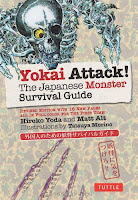 Author: Hiroko Yoda and Matt Alt
Author: Hiroko Yoda and Matt Alt
Illustrator: Tatsuya Morino
Publisher: Tuttle
ISBN: 9784805312193
Released: August 2012
Original release: 2008
Hiroko Yoda and Matt Alt’s Yokai Attack!: The Japanese Monster Survival Guide is one of the primary reasons I have become increasingly interested in yokai and Japan’s supernatural heritage. The book was first published by Kodansha International in 2008, going out of print with the unfortunate demise of its publisher. I was thrilled to learn that Tuttle would be publishing a revised edition of Yokai Attack! in 2012, completely in color with more pages, more yokai, and more illustrations by the book’s artist Tatsuya Morino. I was even more delighted when Alt arranged to have a review copy of the new edition of Yokai Attack! sent to me by Tuttle. It makes me incredibly happy that Yokai Attack!, the first book in Yoda and Alt’s Attack! series (all of which I love), is available once again. And the new edition is even better than the first.
Traditionally, books of yokai lore are organized by the types of places that different yokai are generally found (mountains, bodies of water, households, and so on.) Yokai Attack! takes a different approach to classifying yokai, arranging them and their respective chapters by personality: “Ferocious Fiends,” “Gruesome Gourmets,” Annoying Neighbors,” “The Sexy and the Slimy,” and “The Wimps.” (I think this is a great way to introduce yokai to an audience which may be unfamiliar with them.) Each yokai entry includes useful information such as what the yokai look like, their history and habits, and how to survive an attack or avoid an encounter among many other fun facts. Every yokai included in the guide is illustrated by Morino and many entries are also accompanied by artwork from more traditional sources. Yokai Attack! also includes a preface, a glossary of yokai terminology, a list of resources and recommended reading and viewing, and an index listing the yokai covered in the book in alphabetical order.
Probably my favorite thing about the new edition of Yokai Attack! is the fact that every single page is in full color. The volume simply looks great. I’m particularly pleased to be able to see all of Morino’s artwork in color this time around—it leaves much more of an impression in color than it does in greyscale. I didn’t realize it when I was reading Yokai Attack! for the first time, but Morino was actually an assistant to Shiegeru Mizuki, an influential mangaka who was particularly well known for his yokai stories. Mizuki’s influence on Morino’s artwork can bee seen in Yokai Attack!, making Morino an ideal choice for the guide’s artist. The other great thing about the revised edition of Yokai Attack! is that it includes more yokai than the original, adding entries for te-no-me (which I hadn’t read about before), tsuchi-gumo, and yuki-onna (which I was more familiar with.) This brings the total number of yokai addressed in detail in Yokai Attack! to forty-nine.
Yokai Attack! is a fantastic resource and one of the very few books available on the subject of yokai in English. Yoda and Alt’s approach is both entertaining and informative. Yokai Attack! is a collection of conventional wisdom; most Japanese would probably be familiar with the creatures and stories it contains. However, the guide is written in a style that is accessible for readers who have no previous knowledge of yokai. At the same time, the guide is still engaging for those who do. I particularly appreciate the attention that the authors give to the cultural and historical influences that yokai have had on Japan. It is utterly fascinating stuff. Having previously read Yoaki Attack! and subsequently other books about yokai, I can safely say that it is one of the best and most approachable introductions to yokai available in English. This is even more true of the revised edition of Yokai Attack!. I enjoyed reading it even more than I did the original.
Thank you to Tuttle for providing a copy of Yokai Attack! for review.



